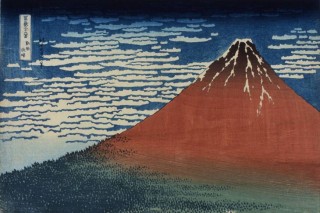Loading
Search
▼ Early Days For Sejima’s Hokusai Museum
- Category:Spot
At some point in the future, the new Sumida Hokusai Museum in Tokyo will be considered with great affection by a lot of people. Like Tokyo Tower and Starck’s Asahi Beer Hall — which have had their fair share of criticism but are now an inextricable part of what makes Tokyo one of the world’s kookiest cities — the asymmetric jumble of silvery blocks designed by celebrated architect Kazuyo Sejima will one day be taken into people’s hearts — probably.
We’re not there yet though. The most blackly comic criticism of the museum I’ve come across is, “We had to suffer the Kanto Earthquake, the bombing of World War II, and now this.” Another priceless pique was, “What about that terrible spiral staircase!” (it only goes between two floors of the building, otherwise people have to cram into two fairly small elevators to move up and down the low-storey building. It also looks puny).
There’s no getting round the brashness of the museum’s design, which appears to have come straight out of the 1990s. The official rubric says the building was planned to blend in with the locality, which is startlingly delusory: It was designed to be flashy, and bask in the attention of being the new kid on the block. It does this very well.
So that’s the wrapping: vainglorious, annoyingly impractical and audacious. Purists may not be enamored of some of the content either. The creepy animatronic figure of Katsushika Hokusai, or the interactive touchscreens enabling you to make your own ukiyo-e print may seem a bit hokey if you were expecting academic seriousness.
One thing the museum is good at showing, though, is that Hokusai was not a purist. The collection communicates very clearly that Hokusai was a regular working stiff, whose output included comics, comedy and porn, as well as art of extraordinary sensibility and finesse. The benefit of having a local museum dedicated to him, rather than to woodblock prints in general, is to put his better-known and sometimes overly familiar pieces into historical context, allowing a greater understanding of why Hokusai’s views of Mount Fuji, and “Under the Wave off Kanagawa” can now be found on mouse mats and key chains around the world.
The centerpiece of “The Return of Hokusai,”the special exhibition marking the inauguration of the museum, features a 7-meter-long
“Landscape Scroll of Scenery at Both Banks of the Sumida River” from 1805. Compared to many of Hokusai’s more immediately eye-catching works, the scroll painting is fairly subdued, banal even. Looking at it in the 21st century, however, its ability to convey the gentle atmosphere of life on the riverbank in the 19th century is very moving. Some things just get better with age.
“The Return of Hokusai” at The Sumida Hokusai Museum runs until Jan. 15; 9:30 a.m.-5:30 p.m. ¥1,200. Closed Mon. hokusai-museum.jp
One thing the museum is good at showing, though, is that Hokusai was not a purist. The collection communicates very clearly that Hokusai was a regular working stiff, whose output included comics, comedy and porn, as well as art of extraordinary sensibility and finesse. The benefit of having a local museum dedicated to him, rather than to woodblock prints in general, is to put his better-known and sometimes overly familiar pieces into historical context, allowing a greater understanding of why Hokusai’s views of Mount Fuji, and “Under the Wave off Kanagawa” can now be found on mouse mats and key chains around the world.
The centerpiece of “The Return of Hokusai,”the special exhibition marking the inauguration of the museum, features a 7-meter-long
“Landscape Scroll of Scenery at Both Banks of the Sumida River” from 1805. Compared to many of Hokusai’s more immediately eye-catching works, the scroll painting is fairly subdued, banal even. Looking at it in the 21st century, however, its ability to convey the gentle atmosphere of life on the riverbank in the 19th century is very moving. Some things just get better with age.
“The Return of Hokusai” at The Sumida Hokusai Museum runs until Jan. 15; 9:30 a.m.-5:30 p.m. ¥1,200. Closed Mon. hokusai-museum.jp
- December 12, 2016
- Comment (0)
- Trackback(0)



